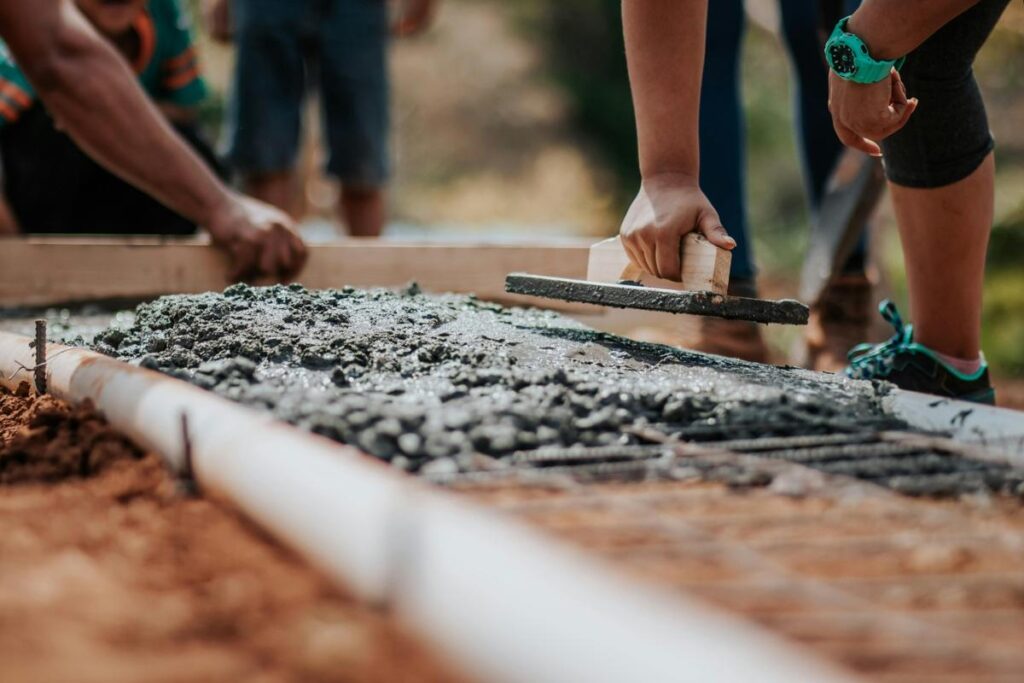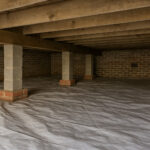When it comes to building or maintaining a home, one of the most important yet overlooked factors is the type of soil beneath your foundation. Whether you’re planning new construction projects or maintaining an existing property, understanding how soil impacts your building foundations can save you thousands of dollars in future repairs.
Among the various types of soil, clay-rich soil poses one of the most significant challenges. Its high moisture content, fine particles, and unpredictable expansion make it one of the most common causes of foundation problems in both residential and commercial buildings.
In this guide, we’ll explore the best foundation for clay soil, what to expect during a free foundation inspection, and how to fix spalling concrete foundations—so you can keep your home safe, stable, and standing strong for the long term.
Understanding the Type of Soil Beneath Your Home
Every strong, stable foundation begins with a thorough understanding of soil. The physical characteristics of the ground—its texture, drainage, and load-bearing capacity—determine the best approach for foundation design and foundation construction.
The Main Soil Types
- Clay Soil: Made up of microscopic clay particles, this soil swells when wet and shrinks when dry. Homes on expansive clay soil often face differential settlement and cracking.
- Sandy Soil: Composed of coarse grains, sandy soil drains well and provides a relatively stable foundation if compacted properly.
- Sandy Loam: A mix of sand, silt, and clay, this is often considered the best soil for building due to its balance of drainage and stability.
- Poor Soil / Organic Matter: Soils rich in organic matter or decomposing material are unstable and not suitable for foundation work without replacement or stabilization.
A geotechnical engineer can test your soil before you build, analyzing clay content, water levels, and soil compaction to recommend the best foundation type for your specific location.
Why Clay Soil Is a Significant Challenge
Clay soil behaves differently than other rock types or well-drained soils. It absorbs a huge amount of water during heavy rains and loses moisture during long periods of dry weather, causing extreme changes in volume. This constant cycle leads to foundation movement known as heaving and settlement.
Clay presents three main issues:
- Expansion: Increased moisture makes the soil swell and push upward on the foundation.
- Contraction: During dry spells, clay shrinks and leaves gaps beneath the foundation.
- Soil Shifts: Uneven changes in moisture content cause one side of the home to move more than the other, leading to cracks and serious problems.
Because of these behaviors, careful planning is crucial before starting any foundation construction in clay-rich areas.
The Best Foundation Types for Clay Soil
Not all foundations are created equal—especially when the ground below is constantly moving. Here are the best foundation types for clay soil and the reasoning behind each option.
1. Pier and Beam Foundation
This design uses concrete piers set deep into firm ground, supporting wooden or steel beams that hold up the home. The crawl space underneath allows for ventilation and easier access to plumbing or electrical systems.
Why it works:
It minimizes the impact of moisture changes and clay’s expansion, creating a more flexible system that can adjust to soil movement.
Best results: Combine this foundation with a good water management system to direct runoff away from the foundation walls.
2. Drilled Pier or Helical Pier Systems
For homes bearing heavy loads or built on expansive clay soil, helical piers and drilled piers are excellent solutions. They transfer the building’s weight below the unstable clay to reach stable soil or bedrock.
Why it works:
Deep foundations bypass the active zone affected by moisture changes. This method is widely used in commercial buildings and custom homes requiring extra stability.
A good idea: Hire a structural engineer or foundation repair contractor to determine pier depth and spacing for your property’s specific soil composition.
3. Raft (Mat) Foundations
Raft foundations—also known as mat foundations—spread the building’s weight over a larger area, reducing pressure on weaker soil. This makes them a great third option for sites with low bearing capacity or poor drainage.
Why it works:
By distributing the load evenly, raft systems reduce differential settlement and help keep the stability of the building consistent, even on shifting clay.
4. Wafflemat System
A modern groundbreaking introduction in the construction industry, the Wafflemat system creates a network of ribs beneath the slab to improve support and resist soil movement.
Why it works:
This design minimizes the risk of cracking and is especially beneficial in areas with long periods of dry weather followed by heavy rains.
5. Post-Tensioned Slab Foundations
Post-tensioned slabs use reinforced steel cables tightened after curing to resist the stress caused by soil shifts and moisture changes. They’re ideal for newer homes in clay-prone regions.
Best foundation type for cost and performance:
These slabs offer durability with less maintenance than shallow foundations while staying more affordable than deep-pier systems.
Foundation Depth, Frost Line, and Water Management
When building on clay soil, it’s important to place the foundation below the frost line—the depth where the ground freezes in winter—to prevent frost heave.
Proper water management is another crucial step. Water should never pool near your foundation walls. Use:
- Grading to slope soil away from your home.
- A water drain or French drain system.
- Extended downspouts.
- Gutter cleaning after heavy rains.
These measures prevent excessive moisture content changes and help maintain a solid foundation.
Free Foundation Inspection: What to Expect
If your home shows signs of cracking, uneven floors, or sticking doors, don’t panic. Start by scheduling a free foundation inspection with a qualified foundation repair contractor.
What Inspectors Look For
- Cracks in interior or exterior walls.
- Signs of differential settlement.
- Gaps between party walls or ceilings.
- Spalling concrete or flaking on exposed surfaces.
- Drainage and grading issues around the property.
Why It’s Worth It
A free foundation inspection gives property owners expert advice without obligation. Even if no repairs are needed, you’ll learn how to maintain your foundation and avoid serious problems later.
Many inspectors can also review your party wall agreement or coordinate with a party wall surveyor if you share walls with neighboring properties—especially in urban developments or row homes.
How to Fix Spalling Concrete Foundations
Spalling occurs when concrete starts flaking or chipping, usually from water infiltration, freeze-thaw cycles, or poor initial construction. Left untreated, it can spread and weaken your foundation walls.
Step 1: Assess the Damage
Identify whether the damage is surface-level or structural. If the spalling is deep or exposing rebar, consult a structural engineer before proceeding.
Step 2: Prepare the Area
- Remove loose concrete using a chisel and hammer.
- Clean the area with a power washer to eliminate dust and debris.
- Ensure the surface is dry before repair.
Step 3: Repair and Refinish
Use a high-quality epoxy patch or polymer-modified mortar to rebuild damaged areas. For foundation work, follow the manufacturer’s curing times closely.
Step 4: Seal and Protect
Once repairs are complete, apply a waterproof concrete sealer. This step prevents future moisture changes and protects against clay’s expansion.
Foundation Repair and Long-Term Maintenance Tips
Even the best foundation type can experience stress over decades. Regular maintenance ensures your foundation solution remains effective.
Keep Soil Moisture Consistent
Use soaker hoses during dry months to maintain balanced moisture and reduce clay shrinkage. Avoid overwatering—just enough to keep soil damp, not soaked.
Compact the Soil Properly
If you’re building or extending, make sure the site undergoes proper soil compaction using plate compactors or heavy equipment. Compacted firm ground supports foundation stability and prevents future sinking.
Address Drainage Immediately
Poor drainage is the main reason many foundations fail. Install or clean your water drain systems regularly and ensure gutters are free of debris.
Check for Changes
During seasonal transitions, monitor for:
- New cracks in drywall or brick.
- Uneven floors.
- Sticky doors or windows.
- Water intrusion after rain.
Small issues caught early are far cheaper to repair.
Building Foundations for Commercial or Larger Properties
For commercial buildings or structures supporting heavy loads, foundations must be designed with extra attention to the load-bearing capacity of the soil.
A geotechnical engineer and structural engineer typically collaborate to determine the right depth and design, often opting for drilled piers, helical piers, or raft foundations on stable soil.
Foundation construction in these cases might also require heavy equipment, soil testing, and even party wall agreements if the project is close to neighboring buildings.
A Note on Foundation Design and Cost
The right foundation is not only about safety—it’s about investment. Costs can range from $8–$15 per square foot, depending on the foundation design, soil conditions, and materials used.
If you’re unsure which route to take, scheduling a free foundation inspection is a good idea. It gives you clarity before spending money on excavation or structural work.
Conclusion: Building on Clay Soil the Right Way
Building or maintaining a home on clay soil takes patience, careful planning, and expert advice. With the right foundation solution, good drainage, and regular maintenance, you can protect your investment for decades.
Remember:
- Understand your type of soil and its physical characteristics.
- Choose the best type of foundation for your climate and soil conditions.
- Schedule a free foundation inspection at the first sign of damage.
- Learn how to fix spalling concrete foundations before small issues escalate.
- Trust certified professionals like a structural engineer or foundation repair contractor for serious work.
With attention to detail and a proactive approach, property owners can ensure their homes rest on a solid foundation—no matter how challenging the soil below.
So whether you’re working with sandy soil, expansive clay soil, or well-drained soils, take your time, seek expert help, and invest in long-term stability. The result? A home that stands strong through extreme changes in weather, soil movement, and time itself.
And to that, we’ll say—good luck with your next foundation project!



